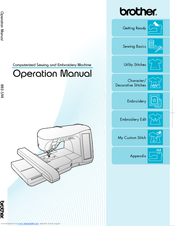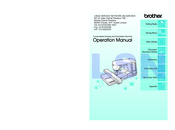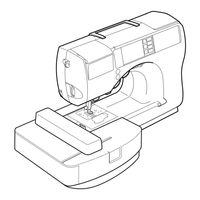Brother Computerized Embroidery Sewing Machine Manuals
Manuals and User Guides for Brother Computerized Embroidery Sewing Machine. We have 3 Brother Computerized Embroidery Sewing Machine manuals available for free PDF download: Operation Manual
Brother Computerized Embroidery Sewing Machine Operation Manual (276 pages)
Computerized Sewing and Embroidery Machine
Brand: Brother
|
Category: Sewing Machine
|
Size: 9 MB
Table of Contents
-
-
-
Lcd Screen23
-
-
Sewing56
-
-
-
-
Dart Seam79
-
I Basting79
-
-
Gathering80
-
Pintuck81
-
Overcasting86
-
Quilting91
-
Appliqué102
-
Scallop Stitches104
-
Top Stitching104
-
Fagoting105
-
Heirloom107
-
I Darning115
-
Bar Tacks117
-
Button Sewing119
-
Eyelet121
-
Zipper Insertion123
-
-
-
Basic Sewing132
-
-
I Key Functions135
-
-
-
-
-
I Key Functions168
-
-
-
-
-
-
Editing Patterns215
-
I Key Functions216
-
-
-
Troubleshooting252
-
Error Messages255
-
I Alarm Sounds260
-
Specifications261
-
Index272
Advertisement
Brother Computerized Embroidery Sewing Machine Operation Manual (225 pages)
computerized sewing and embroidery machine
Brand: Brother
|
Category: Sewing Machine
|
Size: 8 MB
Table of Contents
-
-
Lcd Screen18
-
-
Sewing39
-
-
-
-
Darts Seams54
-
Basting54
-
-
Gathering55
-
Pintucks56
-
-
Overcasting57
-
Appliqués57
-
-
Overcasting59
-
Quilting63
-
Appliqués68
-
Scalloping69
-
Smocking70
-
Fagoting71
-
Darning79
-
Bar Tacks80
-
Eyelets83
-
Side Zipper86
-
-
-
-
Key Functions120
-
-
-
-
-
-
Editing Patterns155
-
-
-
Troubleshooting181
-
Error Messages184
-
Alarm188
-
-
Specifications189
-
Index198
Brother Computerized Embroidery Sewing Machine Operation Manual (166 pages)
Easy Thread Cassette System
Brand: Brother
|
Category: Sewing Machine
|
Size: 3 MB
Table of Contents
-
-
-
Sewing
50
-
-
-
-
Basting79
-
-
-
Piecing99
-
Quilting100
-
Satin Stitching103
-
-
Darning106
-
Eyelet Stitching
108 -
-
Embroidery
117-
Embroidering
140-
Appliquéing142
-
Appendix
151-
Maintenance
152 -
Troubleshooting
154 -
Index
163
-
Advertisement


